Relationship between Meteorological and Air Quality Parameters and COVID-19 in Casablanca Region, Morocco
Abstract
:1. Introduction
2. Materials and Methods
2.1. Data Collection
2.2. Statistical Analysis
3. Results
3.1. Descriptive Statistics of the Parameters
3.2. Spearman Correlations of Meteorological and Air Quality Parameters, and Daily Confirmed COVID-19 Cases
3.3. GAM Model
4. Discussion
5. Conclusions
Author Contributions
Funding
Institutional Review Board Statement
Informed Consent Statement
Data Availability Statement
Acknowledgments
Conflicts of Interest
References
- WHO Coronavirus (COVID-19) Dashboard. Available online: https://covid19.who.int (accessed on 30 December 2020).
- Directorate of Epidemiology and Disease Control, Ministry of Health. Daily COVID-19 Report. 2020. Available online: https://www.sante.gov.ma/Publications/Pages/Bullten_%C3%89pid%C3%A9miologique.aspx (accessed on 30 December 2020).
- Islam, N.; Bukhari, Q.; Jameel, Y.; Shabnam, S.; Erzurumluoglu, A.; Siddique, M.A.; Massaro, J.M.; D’Agostino, R.B. COVID-19 and climatic factors: A global analysis. Environ. Res. 2021, 193, 110355. [Google Scholar] [CrossRef] [PubMed]
- Abraham, J.; Turville, C.; Dowling, K.; Florentine, S. Does Climate Play Any Role in COVID-19 Spreading?—An Australian Perspective. Int. J. Environ. Res. Public Health 2021, 18, 9086. [Google Scholar] [CrossRef] [PubMed]
- Copat, C.; Cristaldi, A.; Fiore, M.; Grasso, A.; Zuccarello, P.; Signorelli, S.S.; Conti, G.O.; Ferrante, M. The role of air pollution (PM and NO(2)) in COVID-19 spread and lethality: A systematic review. Environ. Res. 2020, 191, 110129. [Google Scholar] [CrossRef] [PubMed]
- Chen, S.; Prettner, K.; Kuhn, M.; Geldsetzer, P.; Wang, C.; Bärnighausen, T.; Bloom, D.E. COVID-19 and Climate: Global Evidence from 117 Countries. MedRxiv 2020. [CrossRef]
- Coccia, M. Factors determining the diffusion of COVID-19 and suggested strategy to prevent future accelerated viral infectivity similar to COVID. Sci. Total Environ. 2020, 729, 138474. [Google Scholar] [CrossRef]
- Basray, R.; Malik, A.; Waqar, W.; Chaudhry, A.; Malik, M.W.; Khan, M.A.; Ansari, J.A.; Ikram, A. Impact of environmental factors on COVID-19 cases and mortalities in major cities of Pakistan. J. Biosaf. Biosecurity 2021, 3, 10–16. [Google Scholar] [CrossRef]
- Ali, N.; Fariha, K.A.; Islam, F.; Alam Mishu, M.; Mohanto, N.C.; Hosen, M.J.; Hossain, K. Exposure to air pollution and COVID-19 severity: A review of current insights, management, and challenges. Integr. Environ. Assess. Manag. 2021, 17, 1114–1122. [Google Scholar] [CrossRef]
- Xie, J.; Zhu, Y. Association between ambient temperature and COVID-19 infection in 122 cities from China. Sci. Total Environ. 2020, 724, 138201. [Google Scholar] [CrossRef]
- Bochenek, B.; Jankowski, M.; Gruszczynska, M.; Nykiel, G.; Gruszczynski, M.; Jaczewski, A.; Ziemianski, M.; Pyrc, R.; Figurski, M.; Pinkas, J. Impact of Meteorological Conditions on the Dynamics of the COVID-19 Pandemic in Poland. Int. J. Environ. Res. Public Health 2021, 18, 3951. [Google Scholar] [CrossRef]
- Adhikari, A.; Yin, J. Short-Term Effects of Ambient Ozone, PM2.5, and Meteorological Factors on COVID-19 Confirmed Cases and Deaths in Queens, New York. Int. J. Environ. Res. Public Health 2020, 17, 4047. [Google Scholar] [CrossRef]
- Mecenas, P.; Bastos, R.T.D.R.M.; Vallinoto, A.C.R.; Normando, D. Effects of temperature and humidity on the spread of COVID-19: A systematic review. PLoS ONE 2020, 15, e0238339. [Google Scholar] [CrossRef] [PubMed]
- Majumder, P.; Ray, P.P. A systematic review and meta-analysis on correlation of weather with COVID-19. Sci. Rep. 2021, 11, 1–10. [Google Scholar] [CrossRef] [PubMed]
- Boufekane, A.; Busico, G.; Maizi, D. Effects of temperature and relative humidity on the COVID-19 pandemic in different climates: A study across some regions in Algeria (North Africa). Environ. Sci. Pollut. Res. 2021, 29, 1–26. [Google Scholar] [CrossRef] [PubMed]
- Rahimi, N.R.; Fouladi-Fard, R.; Aali, R.; Shahryari, A.; Rezaali, M.; Ghafouri, Y.; Ghalhari, M.R.; Asadi-Ghalhari, M.; Farzinnia, B.; Gea, O.C.; et al. Bidirectional association between COVID-19 and the environment: A systematic review. Environ. Res. 2021, 194, 110692. [Google Scholar] [CrossRef]
- Dales, R.; Blanco-Vidal, C.; Romero-Meza, R.; Schoen, S.; Lukina, A.; Cakmak, S. The association between air pollution and COVID-19 related mortality in Santiago, Chile: A daily time series analysis. Environ. Res. 2021, 198, 111284. [Google Scholar] [CrossRef]
- Ghanim, A.A.J. Analyzing the severity of coronavirus infections in relation to air pollution: Evidence-based study from Saudi Arabia. Environ. Sci. Pollut. Res. 2021, 29, 6267–6277. [Google Scholar] [CrossRef]
- Meo, S.A.; Alqahtani, S.A.; Binmeather, F.S.; AlRasheed, R.A.; Aljedaie, G.M.; Albarrak, R.M. Effect of environmental pollutants PM2.5, CO, O3 and NO2, on the incidence and mortality of SARS-COV-2 in largest metropolitan cities, Delhi, Mumbai and Kolkata, India. J. King Saud Univ. Sci. 2021, 34, 101687. [Google Scholar] [CrossRef]
- Kogevinas, M.; Castaño-Vinyals, G.; Karachaliou, M.; Espinosa, A.; de Cid, R.; Garcia-Aymerich, J.; Carreras, A.; Cortés, B.; Pleguezuelos, V.; Jiménez, A.; et al. Ambient Air Pollution in Relation to SARS-CoV-2 Infection, Antibody Response, and COVID-19 Disease: A Cohort Study in Catalonia, Spain (COVICAT Study). Environ. Health Perspect. 2021, 129. [Google Scholar] [CrossRef]
- Cambaza, E.M.; Viegas, G.C.; Cambaza, C.M. Potential Impact of Temperature and Atmospheric Pressure on the Number of Cases of COVID-19 in Mozambique, Southern Africa. J. Public Health Epidemiol. 2020, 12, 246–260. [Google Scholar] [CrossRef]
- Ogunjo, S.; Olaniyan, O.; Olusegun, C.; Kayode, F.; Okoh, D.; Jenkins, G. The Role of Meteorological Variables and Aerosols in the Transmission of COVID-19 During Harmattan Season. GeoHealth 2022, 6, 6. [Google Scholar] [CrossRef]
- Adekunle, I.A.; Tella, S.A.; Oyesiku, K.O.; Oseni, I.O. Spatio-temporal analysis of meteorological factors in abating the spread of COVID-19 in Africa. Heliyon 2020, 6, e04749. [Google Scholar] [CrossRef] [PubMed]
- Agency for the Environment and Energy Management. Rules and Recommendations Concerning: Data Validation-Aggregation Criteria-Statistical ParameteRS; Agency for the Environment and Energy Management: Paris, France, 2003. [Google Scholar]
- World Meteorological Organization. Guidelines on Surface Station Data Quality Control and Quality Assurance for Climate Applications (WMO-No. 1269); WMO: Geneva, Switzerland, 2021. [Google Scholar]
- Wood, S.N. Generalized Additive Models: An Introduction with R, 2nd ed.; CRC: Boca Raton, FL, USA, 2017; pp. 1–476. [Google Scholar] [CrossRef]
- Akoglu, H. User’s guide to correlation coefficients. Turk. J. Emerg. Med. 2018, 18, 91–93. [Google Scholar] [CrossRef] [PubMed]
- R: A Language and Environment for Statistical Computing. Available online: https://www.gbif.org/tool/81287/r-a-language-and-environment-for-statistical-computing (accessed on 19 January 2022).
- R: Mixed GAM Computation Vehicle with GCV/AIC/REML Smoothness. Available online: https://stat.ethz.ch/R-manual/R-devel/library/mgcv/html/mgcv-package.html (accessed on 31 December 2021).
- Gasparrini, A.; Armstrong, B.; Kenward, M.G. Distributed lag non-linear models. Stat. Med. 2010, 29, 2224–2234. [Google Scholar] [CrossRef] [PubMed] [Green Version]
- Zhao, M.; Liu, Y.; Gyilbag, A. Assessment of Meteorological Variables and Air Pollution Affecting COVID-19 Cases in Urban Agglomerations: Evidence from China. Int. J. Environ. Res. Public Health 2022, 19, 531. [Google Scholar] [CrossRef] [PubMed]
- Mozumder, M.; Amin, M.; Uddin, M.; Talukder, M. Coronavirus COVID-19 outbreak and control: Effect of temperature, relative humidity, and lockdown implementation. Arch. Pediatr. 2021, 28, 111–116. [Google Scholar] [CrossRef]
- Bu, J.; Peng, D.-D.; Xiao, H.; Yue, Q.; Han, Y.; Lin, Y.; Hu, G.; Chen, J. Analysis of Meteorological Conditions and Prediction of Epidemic Trend of 2019-nCoV Infection in 2020. MedRxiv 2020, 2020, 20022715. [Google Scholar] [CrossRef] [Green Version]
- Cao, H.; Li, B.; Gu, T.; Liu, X.; Meng, K.; Zhang, L. Associations of Ambient Air Pollutants and Meteorological Factors with COVID-19 Transmission in 31 Chinese Provinces: A Time-Series Study. MedRxiv 2020, 2020, 20138867. [Google Scholar] [CrossRef] [PubMed]
- Qi, H.; Xiao, S.; Shi, R.; Ward, M.P.; Chen, Y.; Tu, W.; Su, Q.; Wang, W.; Wang, X.; Zhang, Z. COVID-19 transmission in Mainland China is associated with temperature and humidity: A time-series analysis. Sci. Total Environ. 2020, 728, 138778. [Google Scholar] [CrossRef] [PubMed]
- Sangkham, S.; Thongtip, S.; Vongruang, P. Influence of air pollution and meteorological factors on the spread of COVID-19 in the Bangkok Metropolitan Region and air quality during the outbreak. Environ. Res. 2021, 197, 111104. [Google Scholar] [CrossRef]
- Islam, A.R.M.T.; Hasanuzzaman, M.; Shammi, M.; Salam, R.; Bodrud-Doza, M.; Rahman, M.; Mannan, A.; Huq, S. Are meteorological factors enhancing COVID-19 transmission in Bangladesh? Novel findings from a compound Poisson generalized linear modeling approach. Environ. Sci. Pollut. Res. 2021, 28, 11245–11258. [Google Scholar] [CrossRef]
- Prata, D.N.; Rodrigues, W.; Bermejo, P.H. Temperature significantly changes COVID-19 transmission in (sub)tropical cities of Brazil. Sci. Total Environ. 2020, 729, 138862. [Google Scholar] [CrossRef] [PubMed]
- Moriyama, M.; Hugentobler, W.J.; Iwasaki, A. Seasonality of Respiratory Viral Infections. Annu. Rev. Virol. 2020, 7, 83–101. [Google Scholar] [CrossRef] [PubMed]
- To, T.; Zhang, K.; Maguire, B.; Terebessy, E.; Fong, I.; Parikh, S.; Zhu, J. Correlation of ambient temperature and COVID-19 incidence in Canada. Sci. Total Environ. 2021, 750, 141484. [Google Scholar] [CrossRef]
- Tosepu, R.; Gunawan, J.; Effendy, D.S.; Lestari, H.; Bahar, H.; Asfian, P. Correlation between weather and Covid-19 pandemic in Jakarta, Indonesia. Sci. Total Environ. 2020, 725, 138436. [Google Scholar] [CrossRef] [PubMed]
- Liu, K.; Hou, X.; Ren, Z.; Lowe, R.; Wang, Y.; Li, R.; Liu, X.; Sun, J.; Lu, L.; Song, X.; et al. Climate factors and the East Asian summer monsoon may drive large outbreaks of dengue in China. Environ. Res. 2020, 183, 109190. [Google Scholar] [CrossRef]
- Bilezikian, J.P.; Bikle, D.; Hewison, M.; Lazaretti-Castro, M.; Formenti, A.M.; Gupta, A.; Madhavan, M.V.; Nair, N.; Babalyan, V.; Hutchings, N.; et al. Mechanisms in Endocrinology: Vitamin D and COVID-19. Eur. J. Endocrinol. 2020, 183, R133–R147. [Google Scholar] [CrossRef] [PubMed]
- Sobral, M.F.F.; Duarte, G.B.; Sobral, A.I.G.D.P.; Marinho, M.L.M.; Melo, A. Association between climate variables and global transmission oF SARS-CoV-2. Sci. Total Environ. 2020, 729, 138997. [Google Scholar] [CrossRef] [PubMed]
- Ahmadi, M.; Sharifi, A.; Dorosti, S.; Ghoushchi, S.J.; Ghanbari, N. Investigation of effective climatology parameters on COVID-19 outbreak in Iran. Sci. Total Environ. 2020, 729, 138705. [Google Scholar] [CrossRef]
- Pani, S.K.; Lin, N.-H.; RavindraBabu, S. Association of COVID-19 pandemic with meteorological parameters over Singapore. Sci. Total. Environ. 2020, 740, 140112. [Google Scholar] [CrossRef]
- Bashir, M.F.; Ma, B.; Komal, B.; Bashir, M.A.; Tan, D.; Bashir, M. Correlation between climate indicators and COVID-19 pandemic in New York, USA. Sci. Total Environ. 2020, 728, 138835. [Google Scholar] [CrossRef]
- Şahin, M. Impact of weather on COVID-19 pandemic in Turkey. Sci. Total Environ. 2020, 728, 138810. [Google Scholar] [CrossRef] [PubMed]
- Srivastava, A. COVID-19 and air pollution and meteorology-an intricate relationship: A review. Chemosphere 2021, 263, 128297. [Google Scholar] [CrossRef] [PubMed]
- World Health Organization. Roadmap to Improve and Ensure Good Indoor Ventilation in the Context of COVID-19; WHO: Geneva, Switzerland, 2021; Volume 38. [Google Scholar]
- Carleton, T.; Cornetet, J.; Huybers, P.; Meng, K.C.; Proctor, J. Global evidence for ultraviolet radiation decreasing COVID-19 growth rates. Proc. Natl. Acad. Sci. USA 2021, 118, 2012370118. [Google Scholar] [CrossRef] [PubMed]
- Tan, L.; Schultz, D.M. How Is COVID-19 Affected by Weather? Metaregression of 158 Studies and Recommendations for Best Practices in Future Research. Weather Clim. Soc. 2022, 14, 237–255. [Google Scholar] [CrossRef]
- Zoran, M.A.; Savastru, R.S.; Savastru, D.M.; Tautan, M.N. Assessing the relationship between ground levels of ozone (O3) and nitrogen dioxide (NO2) with coronavirus (COVID-19) in Milan, Italy. Sci. Total Environ. 2020, 740, 140005. [Google Scholar] [CrossRef]
- Li, H.; Xu, X.-L.; Dai, D.-W.; Huang, Z.-Y.; Ma, Z.; Guan, Y.-J. Air pollution and temperature are associated with increased COVID-19 incidence: A time series study. Int. J. Infect. Dis. 2020, 97, 278–282. [Google Scholar] [CrossRef]
- Zoran, M.A.; Savastru, R.S.; Savastru, D.M.; Tautan, M.N. Assessing the relationship between surface levels of PM2.5 and PM10 particulate matter impact on COVID-19 in Milan, Italy. Sci. Total Environ. 2020, 738, 139825. [Google Scholar] [CrossRef]
- Bashir, M.F.; Jiang, B.; Komal, B.; Bashir, M.A.; Farooq, T.H.; Iqbal, N.; Bashir, M. Correlation between environmental pollution indicators and COVID-19 pandemic: A brief study in Californian context. Environ. Res. 2020, 187, 109652. [Google Scholar] [CrossRef]
- Magazzino, C.; Mele, M.; Schneider, N. The relationship between air pollution and COVID-19-related deaths: An application to three French cities. Appl. Energy 2020, 279, 115835. [Google Scholar] [CrossRef]
- Jiang, Y.; Wu, X.-J.; Guan, Y.-J. Effect of ambient air pollutants and meteorological variables on COVID-19 incidence. Infect. Control Hosp. Epidemiol. 2020, 41, 1011–1015. [Google Scholar] [CrossRef]
- Zhu, Y.; Xie, J.; Huang, F.; Cao, L. Association between short-term exposure to air pollution and COVID-19 infection: Evidence from China. Sci. Total Environ. 2020, 727, 138704. [Google Scholar] [CrossRef] [PubMed]
- Phosri, A.; Ueda, K.; Phung, V.L.H.; Tawatsupa, B.; Honda, A.; Takano, H. Effects of ambient air pollution on daily hospital admissions for respiratory and cardiovascular diseases in Bangkok, Thailand. Sci. Total Environ. 2019, 651, 1144–1153. [Google Scholar] [CrossRef] [PubMed]
- Niu, Y.; Chen, R.; Wang, C.; Wang, W.; Jiang, J.; Wu, W.; Cai, J.; Zhao, Z.; Xu, X.; Kan, H. Ozone exposure leads to changes in airway permeability, microbiota and metabolome: A randomised, double-blind, crossover trial. Eur. Respir. J. 2020, 56, 2000165. [Google Scholar] [CrossRef] [PubMed]
- Vo, T.; Paudel, K.; Choudhary, I.; Patial, S.; Saini, Y. Ozone Exposure Upregulates the Expression of Host Susceptibility Protein TMPRSS2 to SARS-CoV-2. Biorxiv 2020, 2020, 377408. [Google Scholar] [CrossRef] [PubMed]
- Cao, J.; Zhang, Y.; Chen, Q.; Yao, M.; Pei, R.; Wang, Y.; Yue, Y.; Huang, Y.; Wang, J.; Guan, W. Ozone Gas Inhibits SARS-CoV-2 Transmission and Provides Possible Control Measures. Aerosol. Sci. Eng. 2021, 5, 516–523. [Google Scholar] [CrossRef]
- Bayarri, B.; Cruz-Alcalde, A.; López-Vinent, N.; Micó, M.M.; Sans, C. Can ozone inactivate SARS-CoV-2? A review of mechanisms and performance on viruses. J. Hazard. Mater. 2021, 415, 125658. [Google Scholar] [CrossRef]
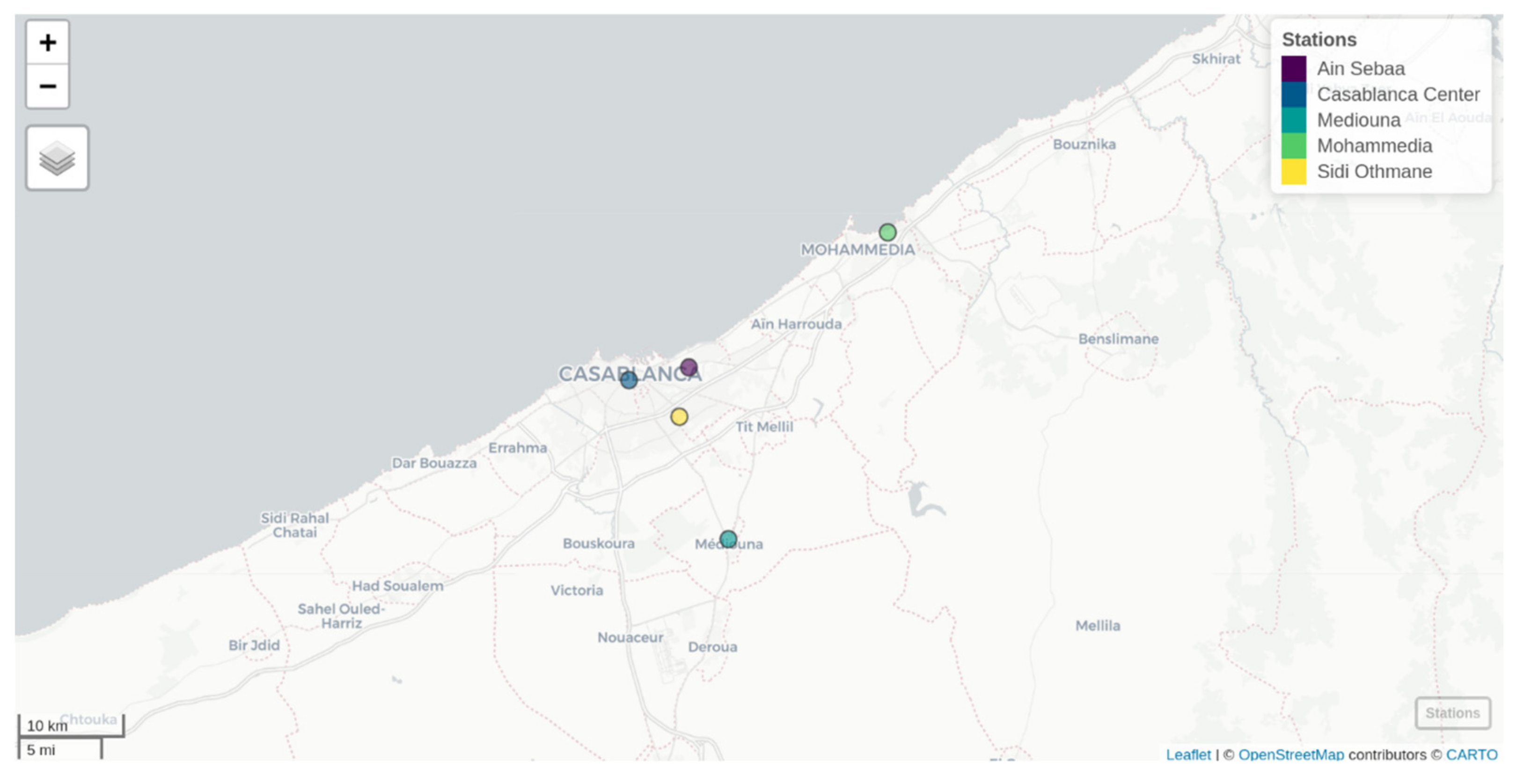
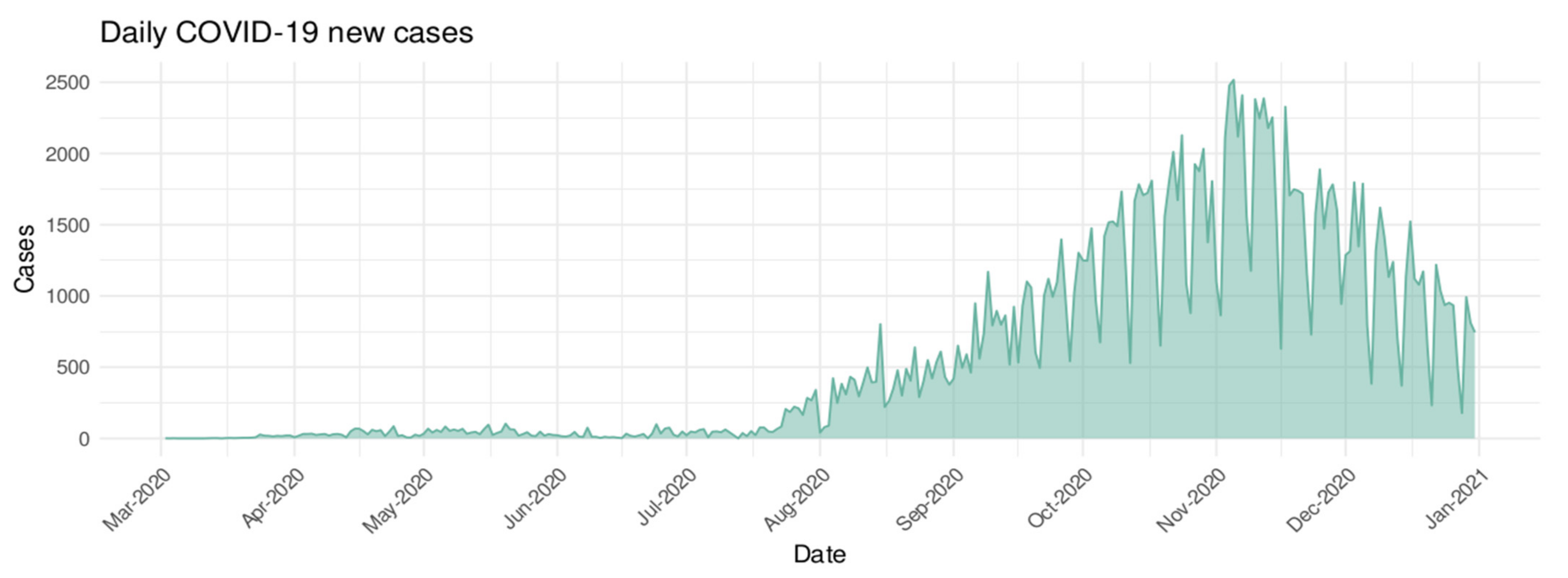
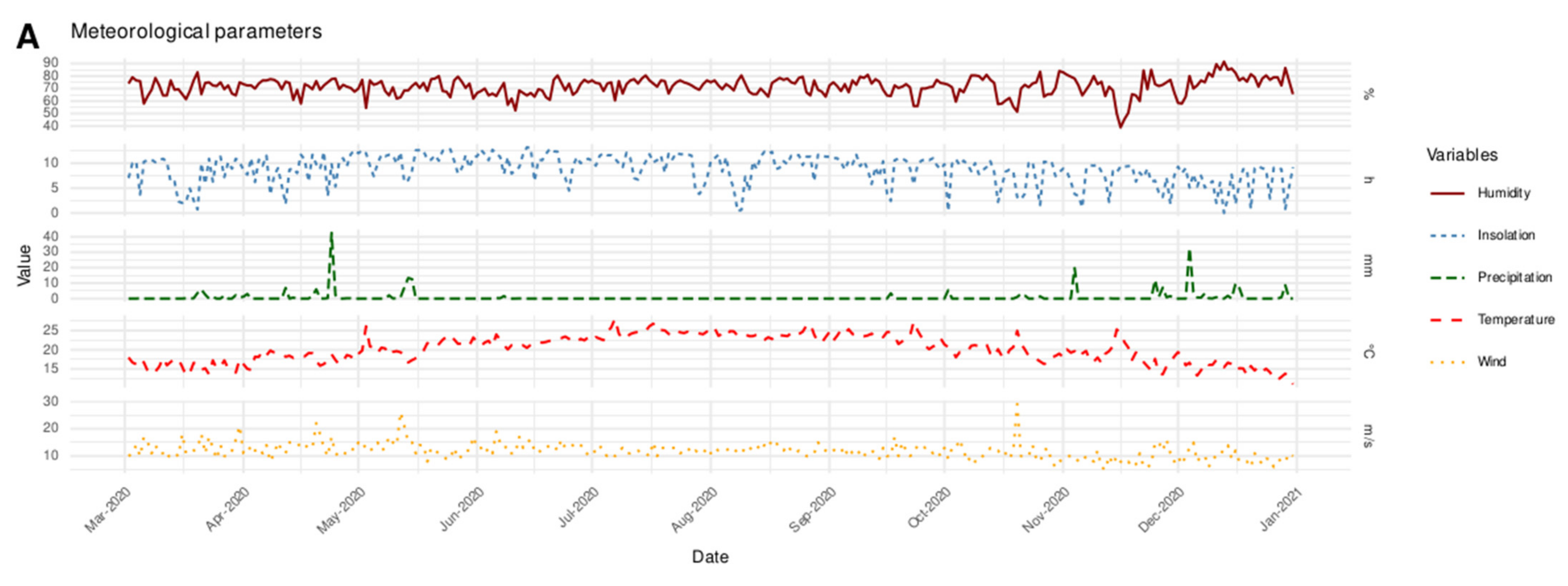
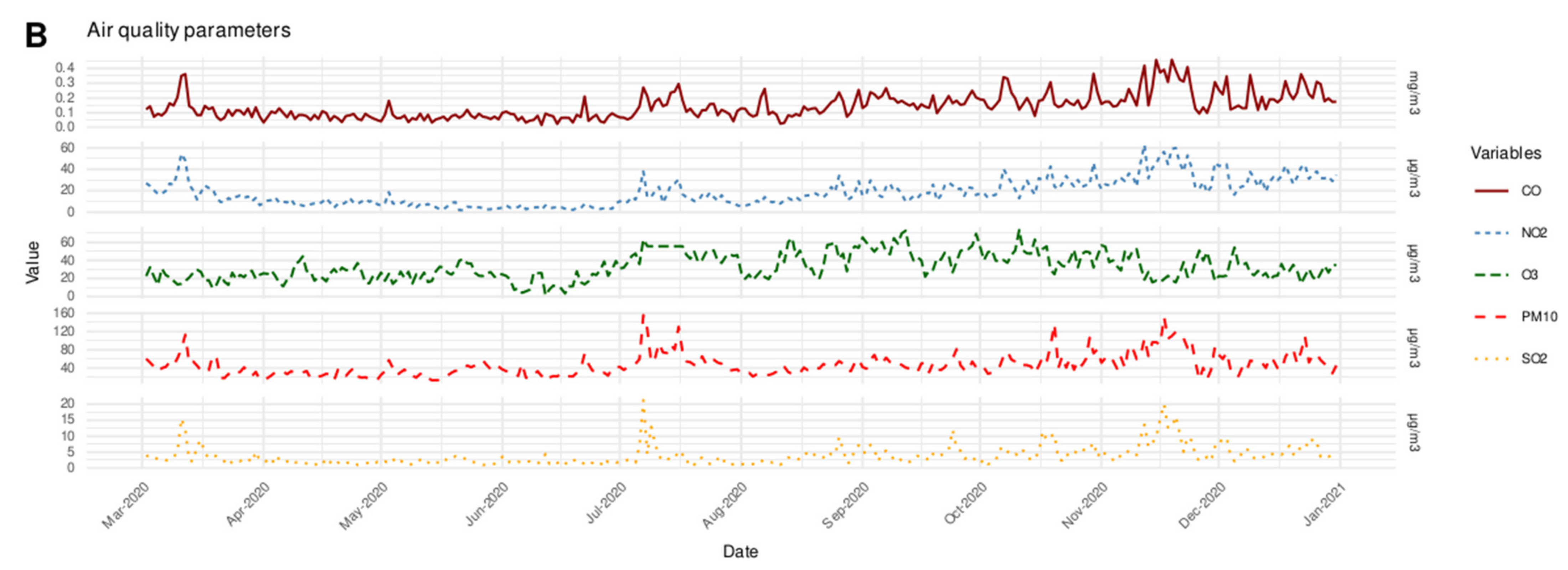

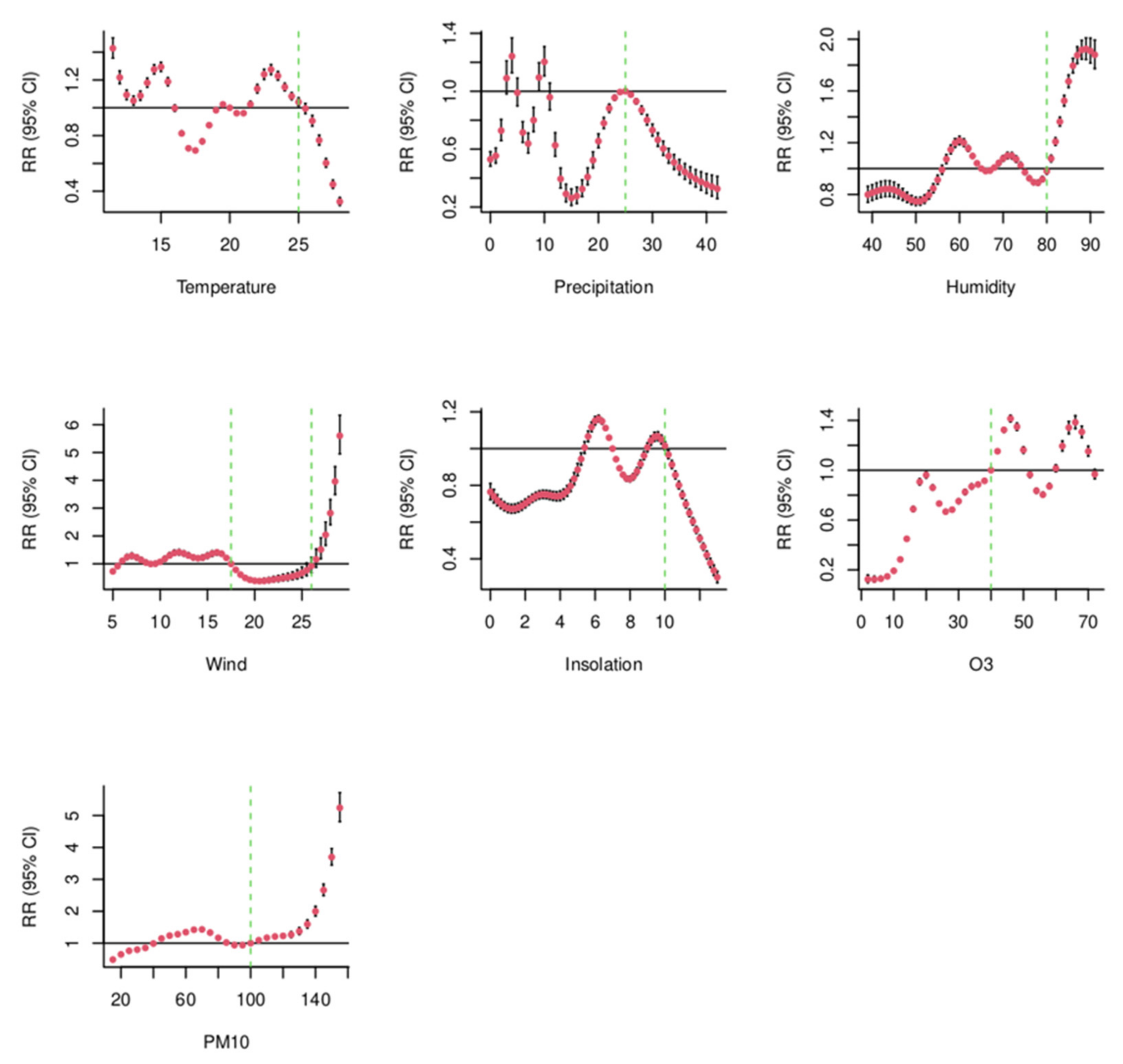
| Variables | Minimum | 25% | Median | 75% | Maximum | Mean | SD |
|---|---|---|---|---|---|---|---|
| Temperature (°C) | 11.05 | 17.35 | 20.35 | 23.35 | 28.15 | 20.13 | 3.58 |
| Precipitation (mm) | 0.00 | 0.00 | 0.00 | 0.00 | 42.50 | 0.83 | 3.68 |
| Humidity (%) | 39.00 | 68.00 | 72.50 | 76.50 | 91.50 | 71.64 | 7.17 |
| Wind (m/s) | 5.00 | 10.00 | 12.00 | 13.00 | 29.00 | 11.83 | 2.97 |
| Insolation (h) | 0.00 | 7.20 | 9.40 | 10.90 | 13.20 | 8.74 | 3.01 |
| CO (mg/m3) | 0.02 | 0.08 | 0.13 | 0.19 | 0.46 | 0.14 | 0.09 |
| NO2 (µg/m3) | 1.80 | 8.46 | 15.29 | 25.50 | 62.88 | 18.41 | 12.72 |
| O3 (µg/m3) | 1.32 | 22.63 | 29.42 | 44.96 | 73.72 | 33.18 | 14.83 |
| PM10 (µg/m3) | 12.59 | 30.10 | 41.42 | 55.65 | 155.75 | 46.40 | 24.50 |
| SO2 (µg/m3) | 0.79 | 1.84 | 3.00 | 4.47 | 21.23 | 3.86 | 3.08 |
| COVID-19 cases | 0.00 | 28.00 | 221.00 | 1024.00 | 2517.00 | 566.38 | 680.17 |
| Variables | Cases | Temperature | Precipitation | Humidity | Wind | Insolation | CO | NO2 | O3 | PM10 |
|---|---|---|---|---|---|---|---|---|---|---|
| Temperature (°C) | −0.18 ** | |||||||||
| Precipitation (mm) | 0.09 | −0.17 ** | ||||||||
| Humidity (%) | −0.02 | −0.16 ** | 0.12 * | |||||||
| Wind (m/s) | −0.36 **** | 0.13 * | 0.14 * | −0.16 ** | ||||||
| Insolation (h) | −0.32 **** | 0.29 **** | −0.20 *** | −0.19 *** | 0.21 *** | |||||
| CO (mg/m3) | 0.56 **** | −0.09 | −0.09 | −0.06 | −0.54 **** | −0.09 | ||||
| NO2 (µg/m3) | 0.65 **** | −0.29 **** | −0.04 | −0.08 | −0.54 **** | −0.22 *** | 0.90 **** | |||
| O3 (µg/m3) | 0.28 **** | 0.33 **** | −0.03 | 0.14 * | −0.10 | 0.06 | 0.13 * | 0.07 | ||
| PM10 (µg/m3) | 0.41 **** | 0.10 | −0.09 | −0.09 | −0.39 **** | −0.07 | 0.76 **** | 0.73 **** | 0.16 ** | |
| SO2 (µg/m3) | 0.42 **** | −0.04 | −0.08 | −0.33 **** | −0.34 **** | −0.06 | 0.72 **** | 0.78 **** | 0.04 | 0.73 ** |
| Variables | EDF | p-Value |
|---|---|---|
| Temperature (°C) | 8.99 | p < 0.001 |
| Precipitation (mm) | 8.75 | p < 0.001 |
| Humidity (%) | 7.99 | p < 0.001 |
| Wind (m/s) | 8.91 | p < 0.001 |
| Insolation (h) | 8.95 | p < 0.001 |
| PM10 (µg/m3) | 8.98 | p < 0.001 |
| O3 (µg/m3) | 8.97 | p < 0.001 |
Publisher’s Note: MDPI stays neutral with regard to jurisdictional claims in published maps and institutional affiliations. |
© 2022 by the authors. Licensee MDPI, Basel, Switzerland. This article is an open access article distributed under the terms and conditions of the Creative Commons Attribution (CC BY) license (https://creativecommons.org/licenses/by/4.0/).
Share and Cite
Khalis, M.; Toure, A.B.; El Badisy, I.; Khomsi, K.; Najmi, H.; Bouaddi, O.; Marfak, A.; Al-Delaimy, W.K.; Berraho, M.; Nejjari, C. Relationship between Meteorological and Air Quality Parameters and COVID-19 in Casablanca Region, Morocco. Int. J. Environ. Res. Public Health 2022, 19, 4989. https://doi.org/10.3390/ijerph19094989
Khalis M, Toure AB, El Badisy I, Khomsi K, Najmi H, Bouaddi O, Marfak A, Al-Delaimy WK, Berraho M, Nejjari C. Relationship between Meteorological and Air Quality Parameters and COVID-19 in Casablanca Region, Morocco. International Journal of Environmental Research and Public Health. 2022; 19(9):4989. https://doi.org/10.3390/ijerph19094989
Chicago/Turabian StyleKhalis, Mohamed, Aly Badara Toure, Imad El Badisy, Kenza Khomsi, Houda Najmi, Oumnia Bouaddi, Abdelghafour Marfak, Wael K. Al-Delaimy, Mohamed Berraho, and Chakib Nejjari. 2022. "Relationship between Meteorological and Air Quality Parameters and COVID-19 in Casablanca Region, Morocco" International Journal of Environmental Research and Public Health 19, no. 9: 4989. https://doi.org/10.3390/ijerph19094989
APA StyleKhalis, M., Toure, A. B., El Badisy, I., Khomsi, K., Najmi, H., Bouaddi, O., Marfak, A., Al-Delaimy, W. K., Berraho, M., & Nejjari, C. (2022). Relationship between Meteorological and Air Quality Parameters and COVID-19 in Casablanca Region, Morocco. International Journal of Environmental Research and Public Health, 19(9), 4989. https://doi.org/10.3390/ijerph19094989







